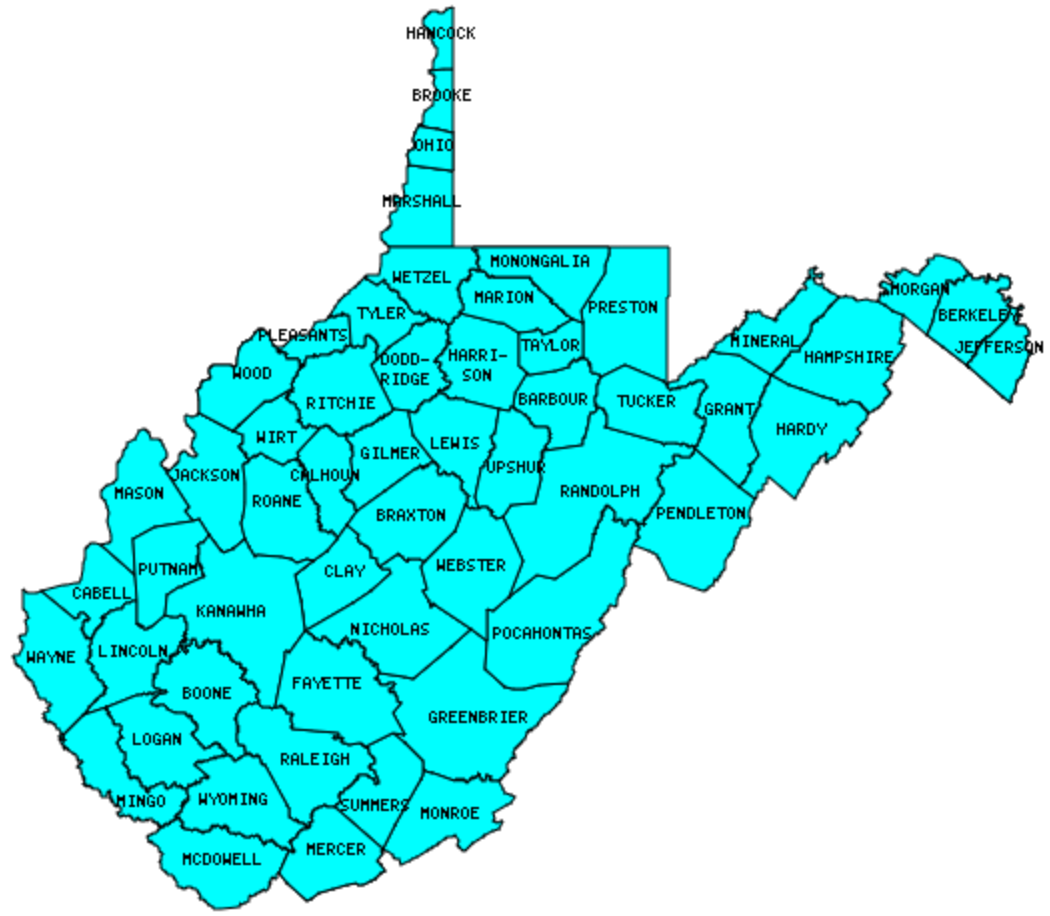
Introduction to West Virginia and Its Counties
West Virginia, nestled within the Appalachian region of the United States, is a state known for its rich history, diverse culture, and breathtaking natural beauty. Officially admitted to the Union on June 20, 1863, West Virginia holds the distinction of being the only state to form by seceding from a Confederate state during the American Civil War. Its historical roots are deeply intertwined with the coal mining industry, which has significantly shaped the state’s economy and culture over the years.
Geographically, West Virginia is bounded by Pennsylvania to the north, Maryland to the east, Virginia to the southeast, Kentucky to the southwest, and Ohio to the northwest. This strategic location has made it a crucial crossroads of various cultural and economic exchanges, contributing to its rich and varied heritage. The state is characterized by its rugged mountain terrain, part of the Appalachian Mountains, which has earned it the nickname “The Mountain State.”
West Virginia’s division into 55 counties is a testament to its administrative and cultural diversity. Each county boasts unique attributes that contribute to the state’s overall identity. From the historical landmarks in Jefferson County to the lush forests of Pocahontas County, every region offers a distinct slice of West Virginia’s character. The counties serve as both political subdivisions and cultural regions, each with its own local government, traditions, and points of interest.
The counties are not just geographical entities but are also central to understanding West Virginia’s historical and cultural fabric. They play a pivotal role in governance, education, and community life, helping to preserve the state’s heritage while fostering growth and development. As we embark on a detailed exploration of each of these 55 counties, it becomes evident how each one contributes to the mosaic that is West Virginia, highlighting the state’s complexity and charm.
The Northern Panhandle Counties
The Northern Panhandle of West Virginia, encompassing Hancock, Brooke, Ohio, and Marshall counties, is a region rich in history and cultural heritage. This area, nestled between Ohio and Pennsylvania, has played a significant role in the industrial and cultural development of the state.
Hancock County, the northernmost county in West Virginia, was established in 1848. Its county seat, New Cumberland, is known for its historical pottery industry, which thrived in the 19th and early 20th centuries. One notable landmark is the Tomlinson Run State Park, offering scenic beauty and recreational opportunities that attract visitors year-round.
Brooke County, formed in 1797, is named after Robert Brooke, a former Governor of Virginia. The county seat, Wellsburg, is home to the Brooke County Courthouse, an architectural marvel listed on the National Register of Historic Places. Wellsburg also hosts the annual Applefest, celebrating the region’s agricultural heritage.
Ohio County, established in 1776, is one of the oldest counties in West Virginia. The city of Wheeling, its county seat, was the first capital of West Virginia and remains a hub of historical and cultural activity. The Wheeling Suspension Bridge, completed in 1849, is a National Historic Landmark and a testament to the region’s engineering prowess. Additionally, the Oglebay Resort and Conference Center offers a blend of natural beauty and recreational facilities, further enhancing the county’s appeal.
Marshall County, named after Chief Justice John Marshall, was founded in 1835. Its county seat, Moundsville, is home to the historic West Virginia Penitentiary, a Gothic-style prison that operated from 1876 to 1995 and now serves as a tourist attraction. The Grave Creek Mound, one of the largest conical burial mounds in the United States, highlights the area’s ancient history and the significance of the Adena culture.
The Northern Panhandle counties have significantly contributed to West Virginia’s industrial growth, particularly through steel manufacturing and coal mining. These industries not only shaped the economic landscape but also fostered a diverse cultural milieu. Today, the region continues to celebrate its heritage while adapting to modern advancements, making it a fascinating area for both residents and visitors alike.
The North-Central Counties
The North-Central region of West Virginia is a tapestry of historical richness, industrial prowess, and educational excellence. Among its notable counties are Monongalia, Marion, Harrison, and Taylor, each contributing uniquely to the state’s legacy.
Monongalia County, often referred to as “Mon County,” is home to Morgantown, a vibrant city that hosts West Virginia University (WVU). Established in 1867, WVU stands as a premier institution fostering academic and research growth. Historically, Monongalia played a significant role in the coal mining industry, which has been a backbone of the local economy for decades. The county also boasts of significant historical events such as the establishment of the first iron furnace west of the Alleghenies in the late 18th century.
Marion County, with Fairmont as its county seat, is another critical player in West Virginia’s historical narrative. The county is recognized for its contributions to the bituminous coal industry. It also houses Fairmont State University, which has been serving the educational needs of the region since 1865. Marion County’s historical significance is further highlighted by events such as the founding of the Mother’s Day holiday by Anna Jarvis in 1908 in Grafton, which was then part of the county.
Harrison County, named in honor of Benjamin Harrison V, a signer of the Declaration of Independence, is a nexus of historical and industrial activity. Clarksburg, the county seat, has been an essential center for glass manufacturing and natural gas production. Harrison County is also the birthplace of Thomas J. “Stonewall” Jackson, a renowned Confederate general during the American Civil War. Additionally, the region’s historical architecture, such as the Waldomore mansion, adds to its rich historical tapestry.
Taylor County, though smaller in population, holds significant historical and industrial relevance. It is historically known for its role in the Baltimore and Ohio Railroad, with Grafton serving as an important rail hub. The county is also home to the International Mother’s Day Shrine, commemorating the birthplace of Mother’s Day. Taylor County’s economy has traditionally been supported by agriculture and coal mining, contributing to the overall industrial landscape of North-Central West Virginia.
In summary, the North-Central counties of West Virginia embody a blend of historical significance, industrial development, and educational achievement. Monongalia, Marion, Harrison, and Taylor counties each offer unique contributions to the state’s rich heritage, making them indispensable to understanding West Virginia’s diverse and storied past.
The Eastern Panhandle Counties
The Eastern Panhandle of West Virginia, comprising Jefferson, Berkeley, and Morgan counties, is a region steeped in colonial history and Civil War significance. Jefferson County, named after Thomas Jefferson, is home to the historic town of Harpers Ferry. This town played a pivotal role in American history, most notably as the site of John Brown’s raid in 1859, which aimed to initiate a slave revolt. Today, Harpers Ferry National Historical Park attracts thousands of visitors annually, offering a rich blend of natural beauty and historical intrigue.
Berkeley County, the oldest county in West Virginia, was established in 1772. Its county seat, Martinsburg, has been a significant hub since colonial times. During the Civil War, Martinsburg’s strategic location made it a focal point of military operations, with both Union and Confederate forces vying for control. Present-day Martinsburg boasts several historical landmarks, such as the Belle Boyd House, named after the famous Confederate spy, and the Adam Stephen House, built by the county’s founder. The town also hosts numerous cultural events, contributing to its vibrant community life.
Morgan County, known for its scenic landscapes and mineral springs, offers a more tranquil experience. The county seat, Berkeley Springs, has been a renowned spa destination since colonial times, frequented by the likes of George Washington. Today, Berkeley Springs State Park continues to draw visitors seeking relaxation and wellness. Additionally, the county is home to Cacapon Resort State Park, offering a variety of outdoor activities including hiking, golfing, and fishing, making it a popular destination for nature enthusiasts.
These Eastern Panhandle counties not only provide a window into America’s past but also offer a range of attractions for modern-day tourists. Whether exploring the historical sites of Harpers Ferry, attending cultural events in Martinsburg, or enjoying the natural beauty of Berkeley Springs, the Eastern Panhandle is a region that beautifully intertwines history and contemporary experiences.
The Potomac Highlands Counties
The Potomac Highlands region of West Virginia is renowned for its breathtaking natural beauty and rich history. This area includes counties such as Grant, Hardy, and Pendleton, each offering unique landscapes and a wealth of outdoor recreational opportunities. Visitors and residents alike are drawn to the region’s picturesque mountains, lush forests, and pristine rivers, making it a haven for nature enthusiasts and adventure seekers.
Grant County, nestled in the heart of the Potomac Highlands, is celebrated for its rugged terrain and scenic vistas. The county is home to the iconic Spruce Knob, the highest peak in West Virginia, which offers spectacular panoramic views. Outdoor activities abound, with hiking, fishing, and camping being popular pastimes. Additionally, the county’s history is preserved in sites like the Hermitage Inn and the historic Fairfax Stone, marking the boundary between West Virginia and Maryland.
Hardy County, with its rolling hills and fertile valleys, provides a perfect backdrop for both outdoor recreation and agricultural pursuits. The South Branch Potomac River winds through the county, offering excellent opportunities for canoeing, kayaking, and fishing. Historical landmarks such as the Lost River State Park and Fort Mill Ridge Civil War Trenches are testaments to the area’s rich past. Hardy County’s economy is bolstered by agriculture, particularly poultry farming, which plays a significant role in sustaining the local community.
Pendleton County, characterized by its dramatic landscapes and tranquil countryside, is a paradise for outdoor enthusiasts. The Seneca Rocks, a prominent climbing destination, attracts climbers from around the nation. The county’s extensive network of trails and pristine wilderness areas, like the Monongahela National Forest, provide ample opportunities for hiking, birdwatching, and wildlife observation. Pendleton County also cherishes its historical sites, including the Confederate Breastworks and the historic town of Franklin. The local economy thrives on tourism, agriculture, and forestry, ensuring a sustainable future for its residents.
Lewis County: A Blend of History and Culture
Lewis County, established in 1816, is named after Charles Lewis, a distinguished officer who died in the Battle of Point Pleasant. The county’s rich history is evident in its well-preserved landmarks, such as the Jackson’s Mill Historic Area, the boyhood home of Confederate General Thomas “Stonewall” Jackson. This site serves as a heritage center and hosts annual events that celebrate the county’s history and agricultural heritage.
The cultural fabric of Lewis County is woven with various festivals and community events, including the West Virginia State Folk Festival, which showcases traditional Appalachian music, crafts, and storytelling. Economically, the county contributes significantly through its timber and natural gas industries, which have been pivotal in sustaining the local economy for decades. The county seat, Weston, is home to the Trans-Allegheny Lunatic Asylum, a National Historic Landmark that offers historical tours and paranormal investigations, drawing visitors from across the nation.
Upshur County: A Hub of Education and Innovation
Founded in 1851, Upshur County is named after Abel Parker Upshur, a former U.S. Secretary of State. Buckhannon, the county seat, is renowned for its vibrant community and educational institutions, most notably West Virginia Wesleyan College. This liberal arts college has been a cornerstone of the county, fostering educational growth and contributing to the local economy.
Upshur County is also known for its contributions to the state’s agricultural sector, with its fertile lands producing a variety of crops and livestock. The annual West Virginia Strawberry Festival, held in Buckhannon, celebrates this agricultural heritage and attracts thousands of visitors. Additionally, the county’s involvement in the development of renewable energy sources, such as wind and solar power, highlights its commitment to innovation and sustainability.
Webster County: Nature’s Playground
Webster County, established in 1860 and named after statesman Daniel Webster, is a haven for nature enthusiasts. The county is characterized by its rugged landscapes, including the Monongahela National Forest, which offers extensive hiking, camping, and fishing opportunities. The Holly River State Park, one of the state’s largest parks, provides a serene retreat for outdoor activities and is a key attraction in the county.
The county’s economy traditionally relied on the timber industry, which remains significant today. However, tourism has increasingly become a vital economic contributor, with events such as the Webster County Woodchopping Festival drawing participants and spectators from various regions. This festival celebrates the county’s logging heritage and includes competitions, parades, and cultural exhibitions.
Collectively, the central counties of Lewis, Upshur, and Webster embody a unique blend of historical significance, cultural richness, and economic diversity. Their contributions to West Virginia’s heritage and economy are indispensable, offering a glimpse into the state’s multifaceted identity.
The Southern Counties
West Virginia’s southern counties, including Raleigh, Fayette, and McDowell, possess a rich tapestry of history intertwined with coal mining, economic challenges, and cultural significance. The coal mining industry, which once thrived in this region, shaped much of the social and economic landscape. Towns grew around the coal mines, and the industry became a critical part of the local economy.
Raleigh County, home to Beckley, is notable for its historical ties to coal mining. The Beckley Exhibition Coal Mine offers a glimpse into the life of miners and the profound impact of coal on the community. Economic challenges arose as the coal industry declined, but the county has since diversified its economy. Modern-day attractions include the Tamarack, showcasing Appalachian arts and crafts, and the New River Gorge, a haven for outdoor enthusiasts.
Fayette County, known for the dramatic New River Gorge, is a blend of natural beauty and historical significance. The New River Gorge Bridge, one of the longest steel arch bridges in the world, is a striking landmark. The region’s coal mining heritage is preserved at the Whipple Company Store, which served as a hub for miners. Despite economic shifts, Fayette County has fostered a growing tourism industry, drawing visitors for white-water rafting, rock climbing, and hiking.
McDowell County, once a powerhouse of coal production, has faced significant economic hardships as the industry waned. The county’s history is marked by the rise and fall of coal, with towns like Welch illustrating the boom of the early 20th century. Despite these challenges, McDowell maintains a strong sense of community and has invested in initiatives to revitalize the area. The Coal Heritage Trail and the Kimball War Memorial are notable sites that honor the region’s history and resilience.
These southern counties of West Virginia, with their deep-rooted coal mining legacy, continue to navigate economic changes while celebrating their cultural and historical heritage. From historical landmarks to natural attractions, Raleigh, Fayette, and McDowell counties offer a unique glimpse into the heart of West Virginia’s past and present.
The Western Counties
The western counties of West Virginia, which include Cabell, Wayne, and Mason, offer a rich tapestry of historical landmarks, economic activities, and cultural contributions. These counties have played pivotal roles in the state’s development and continue to be integral to its identity.
Cabell County is home to the bustling city of Huntington, which was established in 1871 by Collis P. Huntington, a prominent railroad magnate. The city quickly became a major transportation hub, bolstered by the Chesapeake and Ohio Railway. Today, Huntington is known for its vibrant arts scene, anchored by institutions such as the Huntington Museum of Art and Marshall University. The county’s economy is diverse, with significant contributions from healthcare, education, and manufacturing sectors.
Wayne County, named after General “Mad” Anthony Wayne, has a storied past dating back to its formation in 1842. The county’s economy has traditionally been driven by agriculture and coal mining. Key historical figures from Wayne County include Confederate General Albert G. Jenkins, who played a significant role during the Civil War. In recent years, the county has seen growth in tourism, thanks to attractions like the East Lynn Lake and the Wayne County Historical Society Museum, which offer insights into the region’s rich heritage.
Mason County, named in honor of Virginia statesman George Mason, is perhaps best known for the Battle of Point Pleasant, which took place in 1774. This battle is often considered the first engagement of the American Revolutionary War. Point Pleasant, the county seat, houses the Tu-Endie-Wei State Park, which commemorates this historic event. The county’s economy is largely supported by agriculture, with a growing emphasis on agritourism. The annual Mothman Festival, inspired by local folklore, attracts visitors from across the country and highlights the area’s unique cultural contributions.
Collectively, the western counties of West Virginia encapsulate a blend of historical significance, economic vitality, and cultural richness. From the industrial legacy of Cabell to the agricultural traditions of Wayne and Mason, these counties continue to shape the narrative of the Mountain State.
Conclusion: The Diverse Tapestry of West Virginia’s Counties
West Virginia, often referred to as the Mountain State, boasts a remarkable diversity across its 55 counties. Each county is a unique thread in the rich tapestry that forms the state’s cultural and historical fabric. From the bustling urban centers like Charleston in Kanawha County to the serene, natural beauty of Pocahontas County, the variety is both striking and integral to the state’s identity.
Monongalia County, home to West Virginia University, stands as a beacon of education and innovation. Meanwhile, the historic significance of Harpers Ferry in Jefferson County highlights the state’s pivotal role in American history. The coal-rich counties such as Logan and Mingo have been central to the state’s economic development, while the scenic landscapes of Tucker and Greenbrier counties draw nature enthusiasts and tourists alike.
Each county contributes a distinct flavor, whether through its historical landmarks, cultural festivals, or natural wonders. The preservation of these unique aspects is vital, as they collectively narrate the story of West Virginia’s past and present. The role of these counties extends beyond historical significance; they are essential to shaping the state’s future, fostering community spirit, and promoting sustainable growth.
Understanding and appreciating the diverse contributions of each county allows for a deeper connection to the state as a whole. It is through this collective effort that West Virginia can continue to celebrate its heritage while looking forward to a promising future. Preserving the heritage and recognizing the importance of each county ensures that the rich history and culture of West Virginia remain vibrant for generations to come.







